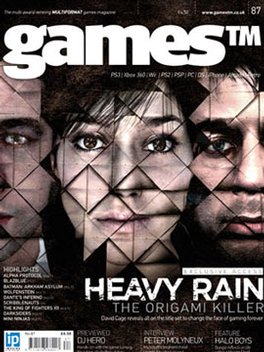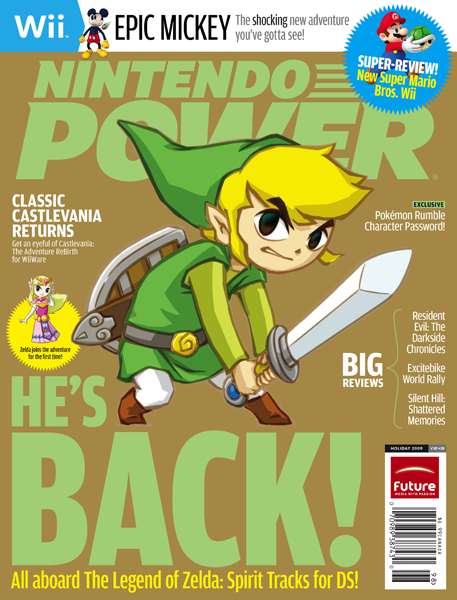This post has not been edited by the GamesBeat staff. Opinions by GamesBeat community writers do not necessarily reflect those of the staff.
After news that EGM was closing hit I may have overreacted. In a state of intense panic I furiously attempted to try to fill the void in my reading itinerary, and found myself subscribing to nearly every gaming magazine that I could find. While I was already an avid reader of Game Informer, the Official Xbox magazine, Nintendo Power and EGM; the addition of Games, Edge, PlayStation and Play felt like a totally rational move.
If there has been one benefit to this overflow of information each month, it is that I now feel like a pretty good judge of what magazines are worth the cost of a subscription.
In that spirit, I give you my personal rankings of the magazines I have been reading.


1 + 2- Games (TM) and Edge–
These magazines come at a hefty price (about $75 for a year's subscription). These British gaming magazines are filled to the brim with extended features, previews and their reviews are both in-depth, and also seem to be stricter on handing out the top scores than American magazines.
They both feel substantial due to the glossy pages and easy to read formatting that is full of detail, yet does not overwhelm the eye. These magazines invite you to enter a conversation, rather than scream at you… which is what some magazines tend to do.
Games manages to edge out Edge with a glorious retro section in the back of each magazine. This section always gets me nostalgic, and seems to lift up gaming's 'glory days' without turning a blind eye to the faults and problems involved in the birth of the classics it covers.
As a matter of fact the most interesting aspects of this section is that it always goes in depth with one title, giving you a heads to tail view of the developmental issues with lead to it being a classic, or crap.
Edge might be the choice for any aspiring games writer or developer, as they offer profiles and information on various development studios. They also have numerous ads for development studios looking to hire new talent as well.
If you miss holding a magazine in your hand, and are finding that your current magazines are not as fulfilling as you would like, then I recommend subscribing to one of these publications.

3- Game Informer–
Lots of people like to look down on Game Informer because they have the advantage of being redundantly pushed by every GameStop employee on Earth. The shame in this is that G.I. actually has great cover stories that are often the first time the public will see unannounced games.
G.I. offers large pictures of the games they cover, and while said coverage can often be too little (any preview that is not the cover story) to too much (cover stories are often not representative of the final product- see the Resistance 2 or Borderlands cover stories), but they are always interesting enough to warrant the $15 subscription, and the Edge card does save you a good bit of money if you trade or buy used games with any regularity.
I do feel like one of the weakest aspects of G.I. are the reviews. Most of the time I do not have a problem with them, but I do tend to feel like they are a bit too quick to hand out top marks, and they seem to think that 7 is an average score. This has not only lead to many games receiving higher marks than they deserve, but has also helped given legitimacy to the idea that any score less than a 9 is worth throwing a shit-fit over.
I also hate, hate, hate partial scores. 8.57… Really? Why?
Would G.I. be the #1 magazine in the world if they did not have the clout of GameStop getting them first dibs at cover stories and more access than other publications? Hell no! But still, what is here is more worth the cheap entrance fee than other magazines that do not have the same level of access.

OXM might not be first to cover a certain story. They might not get the access that an "official" magazine should get. What they do have, though, is thoughtful coverage that is informative and is pleasantly lacking in the fanboy drivel that other "official" magazines tend to reduce themselves to.
OXM manages to, month-to-month, give me enough of a specific viewpoint on the games they cover to warrant a complete read through- even if their story is the fourth rendition of a piece from the same exact press even that all the other magazines I read attended and wrote about.
When OXM gives a game a cover story review, you can guarantee that review is worth reading and in extremely in-depth without becoming an IGN-like chore to read.
The biggest criticism I could give OXM is that it is no longer worth putting in the demo disk if you are subscribed to Xbox Live, and that they should think of more ways to make the disk at integral to the experiencing the magazine as reading the actual printed pages are.

5- Nintendo Power–
Nintendo Power would be higher on this list if it was not for the simple fact that 75% of what comes out on Nintendo's consoles is utter crap designed to hit a younger demographic than me. Because of this I can usually read every article I want to in any given issue in about ten minutes.
Nintendo Power is, however, excellent reading for any Nintendo fan that wishes more of the obscure games coming out were covered by the game press. And since Nintendo is so notoriously stingy in giving information to the press, Nintendo Power is often the first and only place you can go to find information on many of the exclusive Nintendo-brand titles.
If Nintendo Power could beef up their coverage beyond the extremely short write-ups that most titles tend to get and make the whole experience seem a bit more substantive, then they would easily best OXM in the "official" department. As it stands now, NP is a magazine you can skip unless you are the most hardcore type of Nintendo fanboy.

6- Playstation–
By far the most juvenile and unsubstantial of the "official" magazines, I have found very little worth reading in any PlayStation Magazine. I have yet to see any type of information in an issue that I had not already read in another publication already, and their pieces are often so devoid of a specific viewpoint or stance that I honestly find it hard to care in the least about this publication.
It is a bit crazy that PlayStation could not take advantage of the resurgence of the Sony brand this year, but they seem to be more intent on proclaiming 'Sony is teh best, evar!!' to take even the smallest bit of time to improve the quality of coverage.
If you want to read a re-written Sony press release, then by all means subscribe to this magazine. If you want to be more informed about what is on the horizon for the Sony brand, then I would direct you to a number of Sony fan-run sites that manage to get more exclusive information in one week than this "official" publication can muster over a whole month.

7- Play–
Really, Play should be called 'What Dave Halverson Plays,' because their other writers are given so little voice in the pages of this publication that their pieces could be removed and you would still have at least half a magazine to read. This would be a fine situation if Dave was one of the best writers in the business… But he is not.
The only compliment that I can send Dave's way is that he at least has his own point-of-view. That point-of-view may have an extreme tendency to overlook any game's issues and be driven to speak in hyperbole more than any kind of rational criticism… But at least it is distinct and identifiable.
Play is like that guy you knew in high school who tries way too hard to fit in. In this case Play wants desperately to fit in with the Otaku crowd. Sadly, while this could be a cool idea, Play is so poorly formatted that the Otaku aspect feels weirdly shoe-horned in to the gaming portion.
This makes the magazine feels like a disheveled mess, which probably in large part is due to the magazine being so directed by what Dave Halverson feels like writing about any given month.
The way Play made a huge issue over not giving game's scores in the magazine, but then caved in and started to put scores on their website… but not the magazine. Well, honestly it felt like a major cop-out to me.
As does the 10+ score. Really, there are games that are better than perfect? It is an idiot score that could only come from the warped mind of Dave Halverson.
If you are thinking about subscribing to Play, then I honestly submit that walking into your bathroom, throwing ten dollars in the toilet and then flushing might be a better use for your money.
______________________________________________
Overall, there is no doubt in my mind that subscribing to seven gaming magazines was the worst form of overkill possible. Nothing is going to replace EGM for me… except, maybe, for the return of EGM.
I now possess a stack of unread or half-read magazines that will be begging to be read long after I have let my subscriptions for half of these magazines lapse.
The worst part of all of this was that the most expensive magazines turned out to be the most worthwhile, and my wallet can no longer afford to shell out $70 per subscription for two magazines.
Magazines will always have something that the internet will not. It is a tactile and visual experience that will always be dearer to my heart than any online site could ever hope to achieve. Back in the day I used to read EGM front to back twice, sometimes three times in any given month. Now, I tend to go to Kotaku a few times a day to see the latest news and Bitmob to see what types of interesting editorial approaches the Bitmobbers are trying out.
Magazines have a ton to fight against in today's climate. With the internet able to disseminate information quicker than the monthly magazines could ever hope to, they have to find some way to stand apart. Games TM and Edge have that part down pat… it is just too bad that they are so costly that 98% of gamers would never even try them out.
